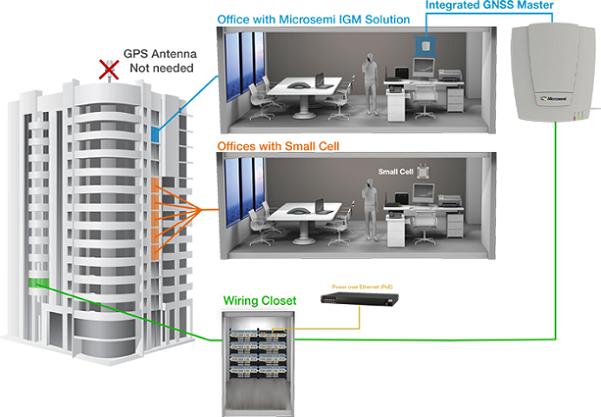Enhanced software for Integrated GNSS Master Portfolio
Microsemi announced significant enhancements to its Integrated Global Navigation Satellite System (GNSS) Master (IGM) software, expanding capabilities and key features in its new version 2 (v2). The company’s IGM product portfolio enables coverage and capacity at the very edge of mobile networks to serve mobile operators preparing for 5G through densification as well as enterprises seeking enhanced indoor capacity and coverage on LTE and LTE-Advanced (LTE-A) networks.
“While the first version of our IGM software demonstrated innovative algorithms for indoor operation, the enhancements in v2 enable mobile operators to leverage enhanced management options, more reliability through GPS back up, better scalability with Internet Protocol (IP)v6 and increased client support to facilitate densification,” said Eric Colard, director of business development for Microsemi’s Frequency and Timing division.
“By leveraging the newest software release on our entire IGM product portfolio, mobile operators can implement a wide range of deployment scenarios―indoor, outdoor, in-building, and in cabinets and huts―with small form factor products which are also highly cost-effective.”
Mobile operators are in the process of deploying phase for LTE and densifying their networks with small cells to enable 4.5G, 4.9G and 5G capabilities. LTE-A and video are driving the need for precise time requirements that are very stringent.
The potential for interference in dense deployments also means strict phase specifications for mitigation. Finally, spectrum is a precious resource that requires usage optimisation leading to a need for precise timing, an area in which Microsemi excels.
The new IGM software enables mobile operators to deploy these smaller grandmasters at the edge of their networks, lowering associated costs and enabling them to serve customers with enhanced coverage and performance.
According to the Global Mobile Suppliers Association (GMSA), LTE has experienced the fastest growth of any mobile infrastructure technology, with 503 networks launched to date in 167 countries and 550 networks expected by the end of 2016.
It is estimated that 25% of LTE operators have already upgraded to LTE-A, driving the need for Microsemi’s leading phase synchronisation technology. Market research firm IHS Infonetics forecasts 2.2 million small cell units in 2016, reflecting a growth rate of 54% compared to 2015 and totaling $1.6 billion for the market. The firm estimates the market to hit $2.6 billion in 2020 at a compound annual growth rate (CAGR) of 15%, with more than 5 million units.
The new software can be loaded on any of the three hardware versions of Microsemi’s IGM product portfolio, the IGM-1100o (outdoor version), the IGM-1100x (with support from external antennas) and the IGM-1100i (indoor version),to support the latest requirements.
Features include support for IPv6, support for the latest Precision Time Protocol (PTP) profiles (G.8275.2) and increased client count from 16 to 32. It also offers the unique ability to provide backup to GPS in case of outage or jamming by accepting a PTP (1588v2) input that will provide a source of time from the network timing infrastructure already deployed. Primary Reference Time Clock (PRTC) compliance is available for IGM 1100x and 1100o as required by ITU, and the system includes cable compensation to address the length of GPS cables.
In addition to the software update announcement, Microsemi also announces the availability of its IGM-1100o device to complement the IGM-1100i and IGM-1100x, available since May 2016. IGM 1100o is the first carrier-grade 1588 PTP GrandMaster in the market integrated with a GNSS antenna available in a form factor to deploy in outdoor environments. The IGM1100o is ideal for outdoor deployment where extended temperature ranges of -40ºC to 70ºC and ruggedisation are critical factors.
The IGM-1100o can simply be installed at an outdoor location such as on top of a cabinet or hut to serve a cluster of eNodeBs or on locations such as a rooftop. IGM-1100o, like all models in the portfolio, is powered by PoE.
The integrated device is connected to the network through an Ethernet cable instead of a GPS cable to simplify deployments and lower costs. It also offers a high level of integration and plug-and-play capabilities.
Microsemi’s new device adds to the recently launched indoor versions, IGM-1100x and IGM-1100i, and each delivers a solution when a cost-effective, precise timing master at the mobile edge is needed.
The entire IGM portfolio leverages the same v2 software, delivering consistent behavior and performance for each form factor. The indoor versions of Microsemi’s IGM devices have been adopted and successfully deployed in the past six months by several top mobile operators, with numerous upcoming deployments worldwide.
The IGM product leverages Microsemi’s broad portfolio for mobile deployment, which includes:
• TimePictra, a modular web-based synchronisation management system that scales and evolves with operational requirements, monitoring the IGM family as well as other Microsemi IEEE 1588 Grand Masters;
• Indoor managed PoE midspans, which allow upgrading the network to support PoE with virtually no downtime. The family includes products with port densities of up to 24 ports and 60 watts per port, to power small cells and the IGM-1100i; and
• Outdoor PoE switches, hubs, midspans and surge protectors, a complete outdoor PoE portfolio, essential for the deployment of the IGM-1100o.
Microsemi’s IGM-1100o, IGM-1100x and IGM-1100i are available now with version 2 software.












